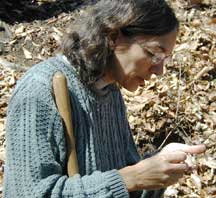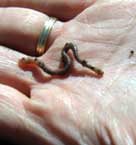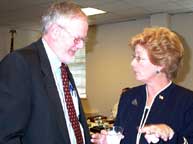 |
| Photos courtesy of Whooping Crane Eastern Partnership |
The Whoopers Have Landed: Cranes Come Home
There’s no telling who whooped loudest, the human witnesses or the cranes, when four wild whooping cranes landed in Necedah National Wildlife Refuge in central Wisconsin on April 19. Larry Wargowsky, refuge manager, says he was just leaving for home when he got a call from Richard Urbanek, tracker with the U.S. Fish and Wildlife Service.
 “The birds are coming home,” Urbanek exclaimed into the receiver. “They’re picking up speed.”
“The birds are coming home,” Urbanek exclaimed into the receiver. “They’re picking up speed.”
The birds had left their roosting grounds in southern Wisconsin late that morning and headed into a strong wind out of the north-northwest. They veered to the east and then banked to the west for a direct bearing on the refuge. They seemed to know exactly where they were going.
Tracker Urbanek relayed their movements to Wargowsky moment by anxious moment.
Wargowsky tried to contact photographers and crane friends, but there was no time. Grabbing his camera and binoculars and keeping in contact with Urbanek, he headed out to the grounds of the refuge.
“It had been overcast all day,” he remarked, “but the sun came out and set in the west just as the birds touched down. It was amazing.” He and Urbanek watched the birds land at 6:37pm. Their landing site was within one mile of the training site where Wargowsky saw their journey south begin last October.
Their touchdown completed a series of flights on a northerly migration, totaling over 1,000 miles in 11 days.
In fact, the journey back was much longer. It has been over a century since a flock of wild migratory whooping cranes completed such a passage in the eastern United States.
Of the 15 species of cranes living in five continents, whoopers are the most rare. A total of 283 wild whoopers and 114 whooping cranes in captive populations live in the United States. The Whooping Crane Eastern Partnership, a joint venture of non-profit and government organizations, is trying to bring back a migratory flock by providing an extra pair of wings.
Historically, crane chicks learned migratory routes by following their parents south. Making a mental map of the route, they returned north the following spring on their own. Now humans and ultralights are taking the place of crane parents
 The four cranes that touched down at Necedah, as well as #7, a fifth crane that was separated from the flock en route and has been foraging in a wildlife area in south-central Wisconsin, were raised last summer at Patuxent Wildlife Refuge Center in Laurel, Maryland. Cared for by human moms in crane suits, they grew up without seeing humans or hearing their voices [“Dances with Cranes”: Vol. IX, No. 44].
The four cranes that touched down at Necedah, as well as #7, a fifth crane that was separated from the flock en route and has been foraging in a wildlife area in south-central Wisconsin, were raised last summer at Patuxent Wildlife Refuge Center in Laurel, Maryland. Cared for by human moms in crane suits, they grew up without seeing humans or hearing their voices [“Dances with Cranes”: Vol. IX, No. 44].
In July of 2001 they were flown to Necedah, where they trained behind an ultralight aircraft, which eventually led them on an odyssey that began on October 17, 2001, and ended 50 days and 1,227 miles later at Chassahowitzka National Wildlife Refuge in Florida.
Eight cranes left Wisconsin. One died en route when it flew into a power line. Two were eaten by bobcats in Florida over the winter. That left five to make the journey home. They left, unassisted, on April 9. Biologists Anne Lacey of the International Crane Foundation and Urbanek followed the flock, tracking them via radio transmitters.
 Undeterred by rain and high winds, they kept on track. Their longest flight was eight and one-half hours.
Undeterred by rain and high winds, they kept on track. Their longest flight was eight and one-half hours.
Now the birds are re-acquainting themselves with their summer home, foraging and making short flights. These birds won’t be fully adult for another five to seven years. Their slow growth to sexual maturity and the loss of wetland habitat are two reasons wild whooping crane population numbers are so low.
Now 20 crane chicks at Patuxent prepare for their journey. They’ll be flown to Necedah this summer and trained on the southerly route. Biologists hope to train a larger population each year, with the end result a healthy, self-sustaining migratory population of wild whooping cranes.
—Martha Blume
 |
| Digging through the soil of Jug Bay Wetlands Sanctuary, Kathy Szlavecz and colleagues discovered a new species of earthworm, Diplocardia patuxentis. |
A New Worm Under the Sun
Kathy Szlavecz trudges through the soggy stream bed peeling back moist bark and peering under dead logs. This one’s too long. Shovel in hand, she digs a couple inches into the mud while the sun casts dappled light over her specimen bags. This one’s too thick. She crunches through piles of leaves to a new spot, digs down deeper and finally finds what she’s looking for.
The thin, sluggish earthworm looks just right to Dr. Szlavecz, an ecologist at Johns Hopkins University. She points out its whitish band (called a clitellumm), its small size and its stiff feel, all of which distinguish this earthworm from the 10 other species that inhabit Jug Bay
Wetlands Sanctuary.
Back in her lab, she’ll confirm that this indeed is not any old earthworm. It’s a new native species that Szlavecz and her colleague, Hungarian earthworm taxonomist Dr. Csaba Csuzdi, recently discovered after digging specimens from Jug Bay last April.
“A lot of people are aware of the tropics because that’s where most of the species are,” Szlavecz said. “But even around here, with a little bit of effort, you can find things that no one has found before.”
Named after the Patuxent River, Diplocardia patuxentis adds to the already high number of native species found in Jug Bay’s protected habitat. Six of the 11 earthworms at Jug Bay are natives, compared to one of five at the Baltimore site where Szlavecz does research.
 “We actually find quite a few native ones here at Jug Bay and that’s partially because this is a wetland and also because it’s protected,” Szlavecz said.
“We actually find quite a few native ones here at Jug Bay and that’s partially because this is a wetland and also because it’s protected,” Szlavecz said.
Jug Bay is a wetlands sanctuary in Anne Arundel County comprising 1,200 acres of wetlands, forests, meadows and fields. Not only earthworms call Jug Bay home. The sanctuary provides habitat for aquatic plants, reptiles, fish and mammals.
So why all the fuss over worms? Earthworms are critical to the soil’s productivity and health. Their boroughs help drain water and make space for plant roots. Their waste dispenses valuable nitrogen and distributes plant nutrients as they mix the soil. Native worms are especially useful because they are specifically adapted to the region.
“What I find fascinating is that the soil systems are incredibly diverse,” Szlavecz said. “There are more species found in soil than in any other part of the forest.”
When you picture earthworms, big, fat, wriggling, pink critters likely come to mind. These introduced worms, called night crawlers, are perfect for fish bait and for gardening, but they may not be perfect for American forests.
Introduced worms often wipe out native species, eat up much of the forest’s leaf litter and drastically change forest ecology, Szlavecz said.
Leaf litter has nearly disappeared in many northern forests, where there is a mysterious decline in flowers and plants. “One possibility is that there’s less leaf litter to protect the plants and the soil dries up.”
But are earthworms responsible for all this change? The verdict isn’t in yet. Scientists are just beginning to study the ecological affects that different worms have on soil, forests and water quality.
“The soil is not very well known,” Szlavecz said, laughing. “If you think about invertebrates you think about butterflies. Who cares about soil?”
Jug Bay director Chris Swarth cares. If he’s successful, so too will buses of school children and other visitors who come to Jug Bay.
“We teach about the importance of biodiversity on healthy ecosystems,” Swarth said. “It’s something that will be worked into our education about the life that’s living here under our feet.”
Feet, however, may be part of the reason so many non-native worms snuck into our soil.
Scientists believe the worms came over with European settlers, stowed in potted plants and in horses’ hooves. Cargo ships played a role as well because they left Europe empty, loaded with soil for weight, Szlavecz said. When they docked in America, they unloaded the foreign dirt, bringing a slew of non-native species. Earthworms were among the newcomers, and they came to stay.
“Humans introduced a lot of species that became much more dominant in these systems. So if you find a native species, it’s a pretty big deal,” she said, shuffling up the wooded hill with a worm that proves a treasure.
—Davene Grosfeld
 In Election Year,
In Election Year,
Anne Arundel Invests in Education
Anne Arundel County Executive Janet Owens may have ruffled some feathers when she delivered her annual budget message to the county council May 1, but she smoothed them at the reception that followed.
Owens ran on an education promise, and education remains her top priority. Since she took office in 1998, the county has risen from 17th to 10th in the state for school expenditures.
But, she says, her work is not yet done.
|“This year I have recommended more than a $22 million increase in the budget for the board of education,” said the executive, who is seeking re-election. “That means two out of every three additional operating dollars the county has to spend are going to the board of education.”
Here’s how the numbers break down. In the county’s $883 million budget, the school funding increase of $22 million will double new investments — only $11 million — in all other county operations.
Those $22 millions would hire 80 new teachers — 40 to reduce middle-school class sizes, 22 in special education, 10 to reduce first-grade class sizes and eight for new students. Owens also proposed full funding of the board of education’s capital request to begin or complete construction on six elementary schools plus Marley Middle School, Anne Arundel High School and the district’s science labs.
The $11 million will bring new year’s raises of two-percent to all county employees,including teachers, police officers and fire fighters. Seven million dollars will renovate police headquarters, improve emergency communications and purchase a new police helicopter. Six million will fund a study of that will help determine where to put new fire departments.
As well as spending to come, Owens spoke of achievements made. She was elected amidst predictions of economic doom, but 15,000 new jobs have followed her with, she said, prospects for more.
“BWI Airport continues with unabated expansion with a tremendous impact on our economy,” she said. “But it also complicates the congestion of our roads and must contribute fairly to dealing with that.”
One such contribution would come from increasing the parking tax at the airport to $1 effective in December.
Owens also took credit for slowing residential growth.
“In these three and a half years,” she said, “I have not granted a single school waiver — and none will be granted this year.” School waivers allow additional residential units to tax the resources of established schools.
“The residential growth that you see is largely the product of waivers granted in prior administrations,” Owens continued. “Ideally, we wish we could have passed legislation to abolish all of those waivers. But we did legislate higher impact fees for the first time since 1986, so that new development pays its fair share.”
Owens’ also claimed 4,000 acres of agricultural land saved from developers.
“But this is no time for self-congratulations,” she said. “It is time to speed up our efforts.”
Among those efforts, she said, should be catching up with the 21st century.
“When I took a oath of office, this county did not even have a website,” she said. To correct matters, Owens plans to create an office of information technology by consolidating 90 positions from other departments.
Other projects include
• the Crofton and West County Regional libraries
• the North County Golf Course;
• the East Park Aquatic Facility Center;
• historical renovation of Bates School;
• $11 million for road repairs and waterway dredging;
• $4 million in human service and cultural arts grants:
• more dog parks.
Owens hopes to achieve her goals while lowering property taxes. She proposed a one-cent reduction across the board, with additional relief for senior citizens. Seniors who earn less than $12,000 would pay no property taxes, while for others property tax credits would increase by 46 to 57 percent according to income.
Owens’ voice wavered throughout her speech, but she shone in the social hour. She hugged county administrators and sat down with voters to discuss the particulars of her budget proposal in Chesapeake Country’s most civilized fashion — over coffee and cookies.
—Brent Seabrook
Way Downstream …
In Virginia, they’re continuing to challenge Maryland’s ownership of the Potomac River even though Maryland is letting Fairfax County build a 700-foot intake pipe to draw water. In a U.S. District Court last week, Virginia challenged the validity of a 1632 land grant from King Charles I to Lord Baltimore ceding ownership of the entire river to the Virginia shoreline …
In Japan, there’s a new sandwich that anti-whaling interests won’t order. You guessed, it’s the Whaleburger, a slab of whale meat with BBQ-like sauce served between two slabs of pressed white rice. It goes for $2.30, but you might choose the whale hot dog instead …
 Our Creature Feature comes from Oregon, where dairy cows are being treated to comfort after a hard-working day — on water beds. The Jongeneel Farm near Mt. Angel is the latest dairy operation to experiment with the bovine waterbeds, which are filled with 18 gallons of water and covered with rubber mats, the Associated Press reports.
Our Creature Feature comes from Oregon, where dairy cows are being treated to comfort after a hard-working day — on water beds. The Jongeneel Farm near Mt. Angel is the latest dairy operation to experiment with the bovine waterbeds, which are filled with 18 gallons of water and covered with rubber mats, the Associated Press reports.
American cows love them, much as do the thousands of European cows already lounging on waterbeds. And farmers are attributing increased milk output to their creatures’ comfort. “When my cows are happy, I’m happy,” Arie Jongeneel said.